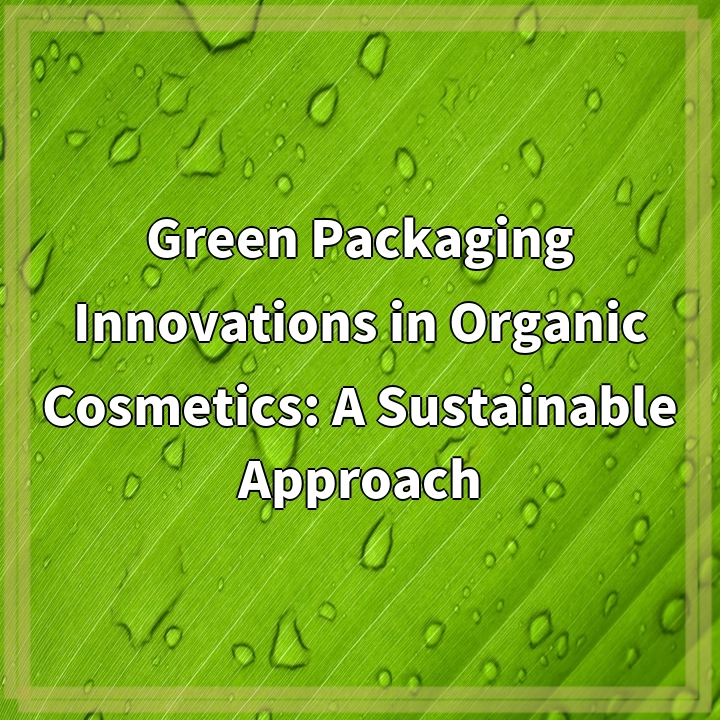Physical Address
304 North Cardinal St.
Dorchester Center, MA 02124
Physical Address
304 North Cardinal St.
Dorchester Center, MA 02124

Green packaging in organic cosmetics refers to the use of environmentally friendly materials and designs that reduce waste and minimize the carbon footprint of beauty products. This innovative approach aligns with the values of sustainability and eco-consciousness, making it an essential aspect of the organic cosmetics industry. Green packaging can involve using biodegradable, compostable, or recyclable materials, as well as optimizing packaging designs to reduce material use and encourage reuse.
Many brands are now opting for packaging that naturally breaks down over time, such as plant-based plastics made from cornstarch or sugarcane.
Utilizing recycled paper, cardboard, or glass not only reduces the demand for new resources but also helps minimize waste in landfills.
A focus on minimalist packaging reduces material waste and often leads to a more aesthetically pleasing product.
Encouraging consumers to refill their containers rather than purchasing new ones helps to decrease packaging waste significantly.
Despite the advancements in green packaging for organic cosmetics, several real-world problems hinder its widespread adoption and effectiveness. One of the primary challenges is the cost associated with producing sustainable packaging solutions. Many eco-friendly materials can be more expensive than traditional plastic, making it difficult for smaller brands to compete in a market driven by affordability.
Consumer Awareness and Education:
Another significant issue is the lack of consumer awareness regarding the importance of green packaging. Many consumers are still unaware of the environmental impact of their purchasing decisions and may prioritize product efficacy and price over sustainability features.
Supply Chain Challenges:
The supply chain for sustainable packaging is still developing, leading to challenges such as limited availability and variability in quality. Inconsistent standards for what constitutes “green” packaging can further complicate matters, leading to potential greenwashing where brands claim sustainability without meeting strict criteria.
Recycling Infrastructure:
Another ongoing problem is the recycling infrastructure itself. Even if a product’s packaging is made from recyclable materials, if local recycling facilities do not accept those materials, they will still end up in landfills. This highlights the need for robust recycling programs and consumer participation in proper waste disposal.
Functional Limitations:
Finally, while many green packaging options are innovative, they may not always meet the functional needs of organic cosmetics. For instance, some biodegradable materials may not provide the same level of product protection as conventional plastics, leading to concerns about product shelf life and efficacy.
To address the challenges associated with green packaging in organic cosmetics, several effective solutions can be considered. By implementing these strategies, brands can enhance their sustainability efforts and promote eco-conscious consumer behavior.
Companies should invest in research and development of cost-effective sustainable materials to create packaging that aligns with eco-friendly principles. Collaboration with suppliers can also lead to bulk purchasing agreements that drive down costs.
Brands must take proactive steps to educate consumers about the importance of green packaging. Marketing campaigns and informational content can highlight the environmental benefits of sustainable practices, encouraging eco-conscious buying decisions.
Developing partnerships with suppliers who prioritize sustainability is key to building a reliable and efficient supply chain. Brands can also advocate for industry-wide standards that define sustainable packaging, promoting consistency across the market.
Collaboration with local governments and recycling organizations can help improve recycling programs and facilities. Brands can also consider offering take-back programs to ensure that their packaging is properly disposed of, encouraging responsible consumer behavior.
Exploring new technologies and materials can result in functional, sustainable packaging that meets the demands of organic cosmetics. Continuous innovation in biodegradable, compostable, and reusable packaging can help bridge the gap between sustainability and product effectiveness.
Green packaging in organic cosmetics is an important aspect of the industry’s commitment to sustainability. By adopting innovative and eco-friendly packaging solutions, brands can reduce waste, minimize their carbon footprint, and promote a more sustainable future.
If you’re wondering where the article came from!
#